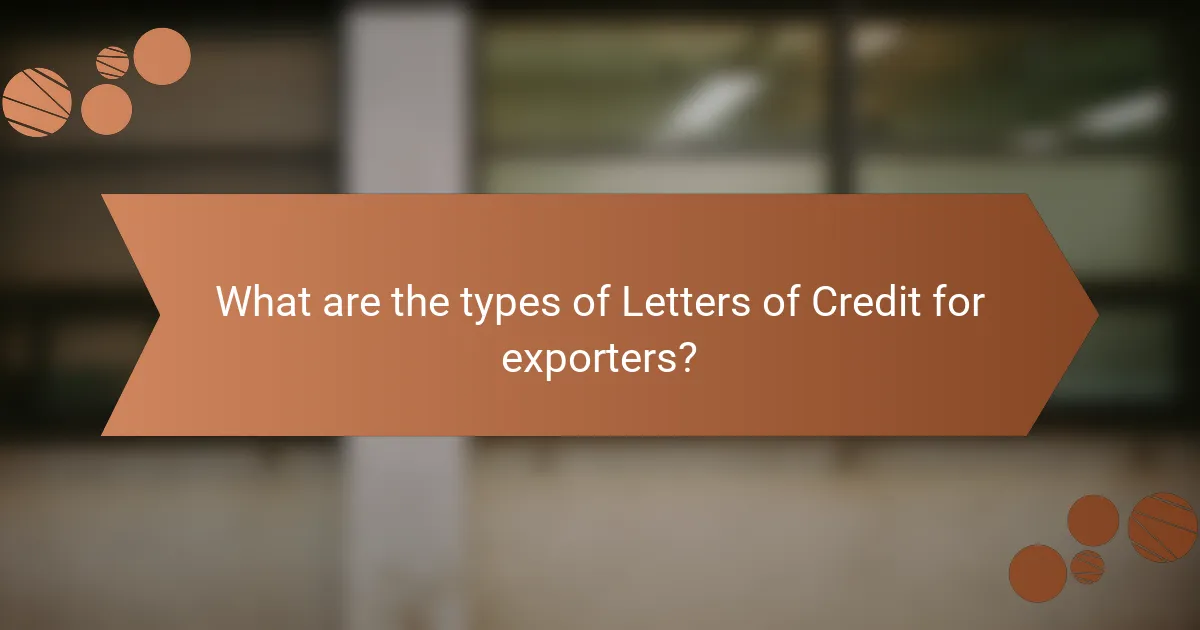Letters of Credit (LCs) are essential tools for exporters engaged in international trade, offering various types to meet specific transaction needs. They provide financial security and mitigate risks, ensuring that exporters receive payment while buyers are assured of the delivery of goods. By applying through a financial institution, exporters can facilitate smoother transactions and build trust in cross-border dealings.

What are the types of Letters of Credit for exporters?
Exporters commonly use several types of Letters of Credit (LCs) to facilitate international trade. Each type serves a specific purpose, providing varying levels of security and flexibility for transactions.
Commercial Letters of Credit
Commercial Letters of Credit are the most widely used type, ensuring that payment is made to the exporter once the required documents are presented. This type of LC is typically used for standard transactions where the buyer and seller have a clear agreement on terms.
Exporters should ensure that the terms outlined in the LC match the sales contract to avoid discrepancies. Common documents required include the bill of lading, invoice, and packing list.
Standby Letters of Credit
Standby Letters of Credit act as a safety net for exporters, guaranteeing payment in case the buyer fails to fulfill their contractual obligations. This type is often used in situations where the exporter wants additional assurance of payment.
While standby LCs are less common for direct transactions, they are useful in securing loans or financing. Exporters should clearly define the conditions under which the standby LC can be drawn upon.
Revolving Letters of Credit
Revolving Letters of Credit allow exporters to draw multiple times within a specified period, making them ideal for ongoing transactions. This type is beneficial for exporters who have a consistent volume of shipments to a buyer.
Exporters should set clear limits on the total amount and duration of the LC to manage cash flow effectively. This arrangement can reduce administrative burdens and expedite future transactions.
Transferable Letters of Credit
Transferable Letters of Credit enable exporters to transfer part or all of the credit to another party, often used when intermediaries are involved. This flexibility allows exporters to engage suppliers without needing to secure additional financing.
Exporters must ensure that the LC is explicitly marked as transferable and understand the fees associated with the transfer process. This type can enhance supply chain efficiency but requires careful management of terms.
Back-to-Back Letters of Credit
Back-to-Back Letters of Credit involve two separate LCs: one issued to the exporter and another to the supplier. This arrangement is useful when the exporter needs to purchase goods from a supplier to fulfill a buyer’s order.
Exporters should be aware of the risks involved, as both LCs must be synchronized to ensure payment flows correctly. Clear communication with all parties is essential to avoid complications in the transaction process.

What are the benefits of using Letters of Credit?
Letters of Credit (LCs) offer significant advantages for exporters, primarily by providing financial security and facilitating international trade. They help mitigate risks associated with cross-border transactions, ensuring that exporters receive payment while buyers can trust the delivery of goods.
Risk Mitigation for Exporters
Using Letters of Credit reduces the risk of non-payment for exporters. By involving a bank as an intermediary, exporters can ensure that payment is guaranteed as long as they meet the terms outlined in the LC. This arrangement protects against buyer insolvency or disputes over contract fulfillment.
Exporters should carefully review the terms of the LC to ensure they align with their contractual obligations. Common pitfalls include misunderstanding the documentation requirements or failing to meet the stipulated deadlines, which can result in payment delays or denials.
Guaranteed Payment
Letters of Credit provide exporters with a guarantee of payment, which is crucial for maintaining cash flow. Once the exporter presents the required documents to the bank, payment is typically made promptly, often within a few days. This assurance allows exporters to plan their finances more effectively.
To maximize the benefits of guaranteed payment, exporters should ensure that all documentation is accurate and complete. Any discrepancies can lead to payment delays, so attention to detail is essential.
Improved Cash Flow
With guaranteed payment from Letters of Credit, exporters can experience improved cash flow, which is vital for sustaining operations. This financial stability allows businesses to reinvest in production, manage expenses, and fulfill other obligations without the stress of uncertain payments.
Exporters can use the cash flow from LCs to negotiate better terms with suppliers or invest in growth opportunities. However, they should be aware of any fees associated with LCs, as these can impact overall profitability.
Enhanced Credibility
Utilizing Letters of Credit enhances the credibility of exporters in the eyes of international buyers. It demonstrates a commitment to secure transactions and builds trust, which can lead to stronger business relationships and repeat customers.
To leverage this credibility, exporters should communicate their use of LCs to potential clients, highlighting the security and professionalism it brings to the transaction. This can be particularly beneficial when entering new markets or working with unfamiliar partners.

How do exporters apply for Letters of Credit?
Exporters apply for Letters of Credit (LCs) by submitting a formal request to a financial institution, which acts as an intermediary between the buyer and seller. This process ensures that the seller receives payment upon fulfilling the terms of the sale, providing security and trust in international trade.
Application Process Overview
The application process for a Letter of Credit typically begins with the exporter submitting an application to their chosen bank. This application includes details about the transaction, such as the amount, currency, and terms of sale.
Once the bank reviews the application and confirms the buyer’s creditworthiness, it issues the LC, which is then sent to the exporter’s bank. This process can take a few days to a couple of weeks, depending on the banks involved and the complexity of the transaction.
Required Documentation
Exporters must provide specific documentation when applying for a Letter of Credit. Common documents include the commercial invoice, packing list, bill of lading, and any certificates required by the buyer or regulatory authorities.
It’s crucial to ensure that all documents comply with the terms outlined in the LC, as discrepancies can lead to payment delays or rejections. Exporters should double-check documentation requirements with their bank to avoid common pitfalls.
Choosing a Financial Institution
Selecting the right financial institution is vital for a smooth LC process. Exporters should consider banks that have experience with international trade and a good reputation for handling LCs efficiently.
Comparing fees, processing times, and customer service can help exporters make an informed decision. It may also be beneficial to choose a bank that has a presence in the buyer’s country to facilitate communication and transactions.
Negotiating Terms and Conditions
Negotiating the terms and conditions of the Letter of Credit is a critical step for exporters. This includes discussing payment terms, shipment deadlines, and any specific requirements that must be met for the LC to be honored.
Exporters should aim for clarity and mutual agreement on all terms to minimize the risk of disputes later. It’s advisable to consult with legal or trade experts to ensure that the terms are favorable and compliant with international trade regulations.

What are the prerequisites for obtaining a Letter of Credit?
To obtain a Letter of Credit (LC), exporters must meet specific prerequisites that ensure the transaction’s security and reliability. Key factors include the exporter’s creditworthiness, the requirements outlined in the export contract, and the nature of their banking relationships.
Creditworthiness Assessment
Creditworthiness is crucial for obtaining a Letter of Credit, as banks assess the financial stability and reliability of the exporter. This evaluation often includes reviewing credit scores, financial statements, and payment histories. Exporters with strong credit profiles are more likely to secure favorable terms.
To improve creditworthiness, exporters should maintain accurate financial records and address any outstanding debts. Engaging with a financial advisor can also help in presenting a strong case to the bank.
Export Contract Requirements
The export contract must clearly specify the terms and conditions under which the Letter of Credit will be issued. This includes details such as the shipment date, payment terms, and required documentation. A well-defined contract minimizes misunderstandings and facilitates smoother processing of the LC.
Exporters should ensure that the contract aligns with the bank’s requirements for the LC. For example, if the bank requires specific shipping documents, these should be explicitly mentioned in the contract to avoid delays.
Banking Relationships
Establishing a solid banking relationship is essential for obtaining a Letter of Credit. Banks prefer working with exporters they know and trust, which can lead to quicker approvals and better terms. Exporters should communicate regularly with their banks to keep them informed about their business activities and needs.
Choosing a bank experienced in international trade can also be beneficial. Such banks understand the complexities of Letters of Credit and can provide valuable guidance throughout the process, ensuring compliance with international regulations and standards.

How do Letters of Credit compare to other payment methods?
Letters of Credit (LCs) offer a secure payment method for exporters, ensuring that funds are available upon meeting specific conditions. Compared to other payment methods, LCs provide a higher level of security and trust between trading partners, making them a preferred choice in international transactions.
Letters of Credit vs. Open Account
Open Account transactions involve shipping goods before payment is made, which can be risky for exporters. In contrast, Letters of Credit require the buyer to secure funds before the exporter ships the goods, minimizing the risk of non-payment. Exporters may prefer LCs to mitigate the financial exposure associated with open accounts.
While open accounts can facilitate smoother transactions and lower costs, they expose exporters to potential defaults. LCs, though they may incur fees, provide a safety net that can be crucial in volatile markets.
Letters of Credit vs. Documentary Collections
Documentary Collections involve banks acting as intermediaries to facilitate payment upon the presentation of shipping documents. Unlike LCs, which guarantee payment, documentary collections do not ensure that funds will be transferred unless the buyer agrees to pay. This makes LCs a more secure option for exporters.
While both methods involve documentation, LCs offer stronger protection as they require the buyer to fulfill specific conditions before payment is released. Exporters should weigh the costs and benefits of each method based on their risk tolerance and the reliability of their trading partners.
Letters of Credit vs. Cash in Advance
Cash in Advance requires the buyer to pay upfront before the goods are shipped, which can deter potential customers. Letters of Credit, on the other hand, provide a compromise between security and flexibility, allowing exporters to ship goods while still ensuring payment. This can help maintain customer relationships while reducing financial risk.
While cash in advance offers maximum security for the exporter, it may limit sales opportunities. LCs can attract more buyers by providing a level of trust and assurance that cash in advance does not, making them a more balanced approach in international trade.



